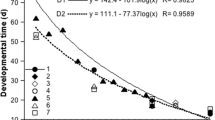Abstract
Populations of Diaptomus leptopus (Copepoda: Calanoida) and other calanoid copepods exhibit varying degrees of sexual size dimorphism. We examined whether intraspecific or interspecific variation in dimorphism could be explained by allometry, and we examined the relationship between adult size attained and development rate to determine any relationship between the two. We compared the degree of sexual size dimorphism in D. leptopus and in other calanoid copepods inhabiting temporary and permanent habitats. Allometry did not explain variation in sexual size dimorphism within or among populations or among species. Permanence of habitat affected the degree of dimorphism: dimorphism was greater within and among species inhabiting temporary environments. Non-significant differences in development rate were found among populations and significant differences were found between sexes of D. leptopus when reared under identical laboratory conditions: males developed more rapidly than females but there was no general relationship between development rate and adult size. Potential adaptive hypotheses to explain the differences between populations inhabiting temporary and permanent habitats are discussed.
Similar content being viewed by others
Refernces
Abdullahi BA, Laybourn-Parry J (1985) The effect of temperature on size and development in three species of benthic copepod. Oecologia 67:295–297
Abouheif E (1995) A comparative analysis of the allometry for sexual size dimorphism: testing Rensch's Rule. M Sc thesis, Concordia University
Anderson RS (1974) Crustacean plankton communities of 340 lakes and ponds in and near the National Parks of the Canadian Rocky Mountains. J. Fish Res. Board Can. 31:855–869
Bayly IAE (1964) A revision of the Australasian species of the freshwater genera Boeckella and Hemiboeckella (Copepoda: Calanoida). Aust J Mar Freshwater Res 15:180–236
Bayly IAE (1978) Variation in sexual dimorphism in nonmarine calanoid copepods and its ecological significance. Limnol Oceanogr 23:1224–1228
Blais J, Maly EJ (1993) Differential predations of Chaoborus americanus on males and females of two species of Diaptomus. Can J Fish Aquat Sci 50:410–415
Brooks JL, Dodson SI (1965) Predation, body size, and composition of plankton. Science 150:28–35
Cheverud JM, Dow MM, Leutenegger W (1985) The quantitative assessment of phylogenetic constraints in comparative analyses: sexual dimorphism in body weight among primates. Evolution 39:1335–1351
Dussart BH, Defaye D (1995) Copepoda: introduction to the copepoda. SPB Academic, Amsterdam
DeFrenza J, Kirner RJ, Maly EJ, Leeuwen HC van (1986) The relationships of sex size ratio and season to mating density in some calanoid copepods. Limnol Oceanogr 31:491–496
Escribano R, McLaren IA (1992) Testing hypotheses of exponential growth and size-dependent molting rate in two copepod species. Mar Biol 114:31–39
Fairbairn DJ (1990) Factors influencing sexual size dimorphism in temperate water striders. Am Nat 136:61–86
Fairbairn DJ, Preziosi RF (1994) Sexual selection and the evolution of allometry for sexual size dimorphism in the water strider Aquarius remigis. Am Nat 144:101–118
Geddes MC, Cole GA (1981) Variation in sexual size differentiation in North American diaptomids (Copepoda: Calanoida): does variation in the degree of dimorphism have ecological significance. Limnol Oceanogr 26:367–374
Gilbert JJ, Williamson CE (1983) Sexual dimorphism in zooplankton (Copepoda, Cladocera, and Rotifera). Annu Rev Ecol Syst 14:1–33
Grad G, Maly EJ (1988) Sex size ratio and their influence on mating success in a calanoid copepod. Limnol Oceanogr 33:1629–1634
Grad G, Maly EJ (1992) Further observation relating sex size ratios to mating success in calanoid copepods. J Plankton Res 14:903–913
Hall DJ, Threlkeld ST, Burns CW, Crowley PH (1976) The sizeefficiency hypothesis and the size structure of zooplankton cummunities. Annu Rev Ecol Syst 7:177–208
Jamieson C, Burns CW (1988) The effects of temperature and food on copepodite development, growth and reproduction in three species of Boeckella (Copepoda: Calanoida). Hydrobiologia 164:235–257
Landry MR (1983) The development of marine calanoid copepods with comment on the isochronal rule. Limnol Oceanogr 28: 614–624
Leeuwen HC van, Maly EJ (1991) Changes in swimming behavior of male Diaptomus laptopus (Copepoda: Calanoida) in response to gravid females. Limnol Oceanogr 36:1188–1195
Maier G (1992) Metacyclops minutus (Claus 1863)-population dynamics and life history characteristics of a rapidly developing copepod. Int Rev Ges Hydrobiol 77:455–466
Maier G (1994) Patterns of life history among cyclopoid copepods of central Europe. Freshwater Biology 31:77–86
Maly EJ (1973) Density, size and clutch of two high altitude diaptomid copepods. Limnol Oceanogr 18:840–848
McLaren IA, Tremblay MJ, Corkett CJ, Roff JC (1989) Copepod production on the Scotian Shelf based on life-history analyses and laboratory rearings. Can J Fish Aquat Sci 46:560–583
O'Brien FI, Winner JM, Krochak DK (1973) Ecology of Diaptomus leptopus S A Forbes (Copepoda: Calanoida) under temporary pond conditions. Hydrobiologia 43:137–155
Reiss MJ (1989) The allometry of growth and reproduction. Cambridge University Press, Cambridge
Rensch B (1959) Evolution above the species level. Columbia University Press, New York
Ricker WE (1984) Computation and uses of central trend lines. Can J Zool 62:1897–1905
Rodriguez V, Jimenez F (1990) Co-existence within a group of congeneric species of Acartia (Copepoda Calanoida): sexual dimorphism and ecological niche in Acartia grani. J Plankton Res 12:497–511
Smyly WJP (1968) Number of eggs and body size and the freshwater copepod Diptomus gracilis Sars in the English Lake District. Oikos 19:323–338
Stemberger RS (1981) A general approach to the culture of planktonic rotifers. Can J Fish Aquat Sci 38:721–724
Ward HB, Whipple GC (1959) Freshwater biology, 2nd edn. Wiley, New York
Watras CJ, Haney JF (1980) Oscillation in the reproductive condition of Diaptomus leptopus (Calanoida: Calanoida) and their relation to rates of egg-clutch production. Oecologia 45:94–103
Author information
Authors and Affiliations
Rights and permissions
About this article
Cite this article
Nishikawa, T.S., Maly, E.J. Factors influencing the degree of sexual size dimorphism within and among calanoid copepod species. Oecologia 107, 490–497 (1996). https://doi.org/10.1007/BF00333940
Received:
Accepted:
Issue Date:
DOI: https://doi.org/10.1007/BF00333940




